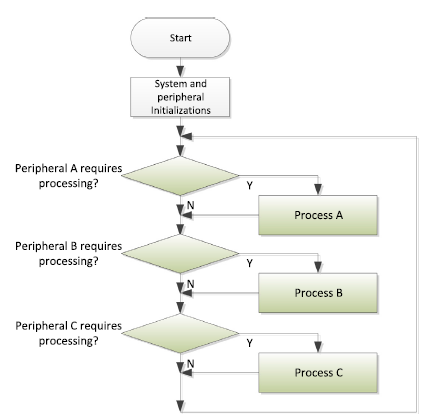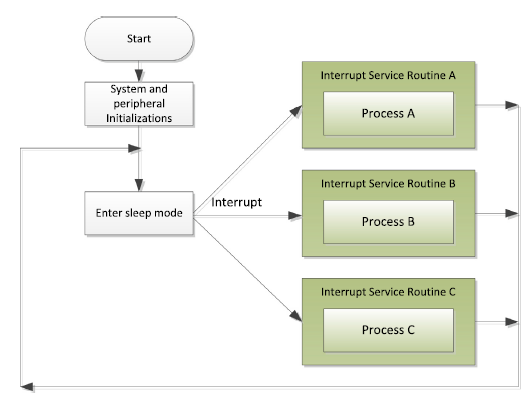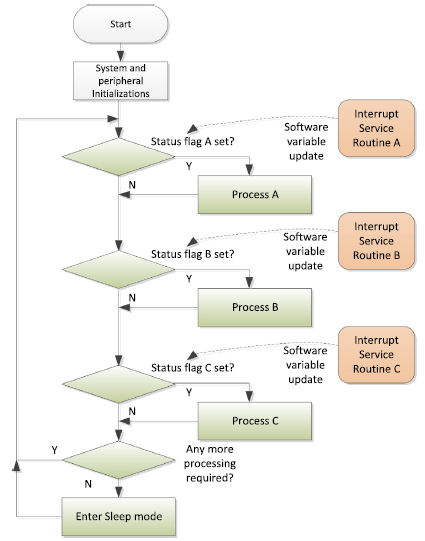 |
RainbowBS Manual
v0.1.0
Written by QWQ([email protected])
|
Table of Contents
Application Model Introduction
From the view of application developers for an embedded system,there are mainly two ways to construct program for an application.
Event-Driven application model
This model is very suitable for simple applications.Two methods are used,polling or interrupt driven.
For polling method,the processor can wait for data ready to process it,and wait again. The polling method works well for very simple applications, but it has several disadvantages. For example, when the application gets more complex, the polling loop design might get very difficult to maintain. Also, it is difficult to define priorities between different services using polling and you might end up with poor responsiveness, where a peripheral requesting service might need to wait a long time while the processor is handling less important tasks.And lots of energy is wasted during the polling when service is not required.
 polling method
polling methodFor interrupt driven method,almost all micro-controllers have some sort of sleep mode support to reduce power, in which the peripheral can wake up the processor when it requires a service.Interrupts from different peripherals can be assigned with different interrupt priority levels so that this allows much better responsiveness..
 interrupt driven method
interrupt driven methodIn some cases, the processing of data from peripheral services can be partitioned into two parts: the first part needs to be done quickly, and the second part can be carried out a little bit later. In such situations we can use a mixture of interrupt-driven and polling methods to construct the program. When a peripheral requires service, it triggers an interrupt request as in an interrupt-driven application. Once the first part of the interrupt service is carried out, it updates some software variables so that the second part of the service can be executed in the polling-based application code.
 mixed polling and interrupt driven method
mixed polling and interrupt driven methodUsing this arrangement, we can reduce the duration of high-priority interrupt handlers so that lower priority interrupt services can get served quicker. At the same time, the processor can still enter sleep mode to save power when no servicing is needed.
Multi-Threaded application model
When the applications get more complex, a polling and interrupt-driven program structure might not be able to handle the processing requirements. For example, some tasks that can take a long time to execute might need to be processed concurrently. This can be done by dividing the processor’s time into a number of time slots and allocating the time slots to these tasks. While it is technically possible to create such an arrangement by manually partitioning the tasks and building a simple scheduler to handle this, it is often impractical to do this in real projects as it is time consuming and can make the program much harder to maintain and debug.
In these applications, a Real-Time Operating System(RTOS) can be used to handle the task scheduling (Figure 2.11). An RTOS allows multiple processes to be executed concurrently, by dividing the processor’s time into time slots and allocating the time slots to the processes that require services. A timer is need to handle the timekeeping for the RTOS, and at the end of each time slot, the timer generates a timer interrupt, which triggers the task scheduler and decides if context switching should be carried out. If yes, the current executing process is suspended and the processor executes another process.
 multi-thresded method
multi-thresded method
Application Model Supported by RBS
There are three optional application model to write your application code based on RBS.
Normal Model
This is an event-driven system model so that an endless loop is needed in
main().OS Model
This is a multi-threaded system model so that an OS kernel is needed.
Prptothread Process Model
This is an event-driven system with multi-threaded liked blocking property.
Protothreads are a extremely lightweight, stackless type of threads that provides a blocking context on top of an event-driven system, without the overhead of per-thread stacks. The purpose of protothreads is to implement sequential flow of control without complex state machines or full multi-threading. Protothreads provides conditional blocking inside C functions.
The advantage of protothreads over a purely event-driven approach is that protothreads provides a sequential code structure that allows for blocking functions. In purely event-driven systems, blocking must be implemented by manually breaking the function into two pieces - one for the piece of code before the blocking call and one for the code after the blocking call. This makes it hard to use control structures such as if() conditionals and while() loops.
The advantage of protothreads over ordinary threads is that a protothread do not require a separate stack. In memory constrained systems, the overhead of allocating multiple stacks can consume large amounts of the available memory. In contrast, each protothread only requires between two and twelve bytes of state, depending on the architecture.
Protothread Process
The protothreads library was written by Adam Dunkels adam@.nosp@m.sics.nosp@m..se with support from Oliver Schmidt ol.sc.nosp@m.@web.nosp@m..de.
Protothreads are a extremely lightweight, stackless threads that provides a blocking context on top of an event-driven system, without the overhead of per-thread stacks. The purpose of protothreads is to implement sequential flow of control without using complex state machines or full multi-threading. Protothreads provides conditional blocking inside a C function.
In memory constrained systems, such as deeply embedded systems, traditional multi-threading may have a too large memory overhead. In traditional multi-threading, each thread requires its own stack, that typically is over-provisioned. The stacks may use large parts of the available memory.
The main advantage of protothreads over ordinary threads is that protothreads are very lightweight: a protothread does not require its own stack. Rather, all protothreads run on the same stack and context switching is done by stack rewinding. This is advantageous in memory constrained systems, where a stack for a thread might use a large part of the available memory. A protothread only requires only two bytes of memory per protothread. Moreover, protothreads are implemented in pure C and do not require any machine-specific assembler code.
A protothread runs within a single C function and cannot span over other functions. A protothread may call normal C functions, but cannot block inside a called function. Blocking inside nested function calls is instead made by spawning a separate protothread for each potentially blocking function. The advantage of this approach is that blocking is explicit: the programmer knows exactly which functions that block that which functions the never blocks.
Protothreads are similar to asymmetric co-routines. The main difference is that co-routines uses a separate stack for each co-routine, whereas protothreads are stackless. The most similar mechanism to protothreads are Python generators. These are also stackless constructs, but have a different purpose. Protothreads provides blocking contexts inside a C function, whereas Python generators provide multiple exit points from a generator function.
Detail referances to protothread process protothread process
Local variables
- Note
- Because protothreads do not save the stack context across a blocking call, local variables are not preserved when the protothread blocks. This means that local variables should be used with utmost care - if in doubt, do not use local variables inside a protothread!
Scheduling
A protothread is driven by repeated calls to the function in which the protothread is running. Each time the function is called, the protothread will run until it blocks or exits. Thus the scheduling of protothreads is done by the application that uses protothreads.
Implementation
Protothreads are implemented using local continuations. A local continuation represents the current state of execution at a particular place in the program, but does not provide any call history or local variables. A local continuation can be set in a specific function to capture the state of the function. After a local continuation has been set can be resumed in order to restore the state of the function at the point where the local continuation was set.
Local continuations can be implemented in a variety of ways:
- by using machine specific assembler code.
- by using standard C constructs.
- by using compiler extensions.
The first way works by saving and restoring the processor state, except for stack pointers, and requires between 16 and 32 bytes of memory per protothread. The exact amount of memory required depends on the architecture.
The standard C implementation requires only two bytes of state per protothread and utilizes the C switch() statement in a non-obvious way that is similar to Duff's device. This implementation does, however, impose a slight restriction to the code that uses protothreads in that the code cannot use switch() statements itself.
Certain compilers has C extensions that can be used to implement protothreads. GCC supports label pointers that can be used for this purpose. With this implementation, protothreads require 4 bytes of RAM per protothread.
Generated by
 1.8.9.1
1.8.9.1